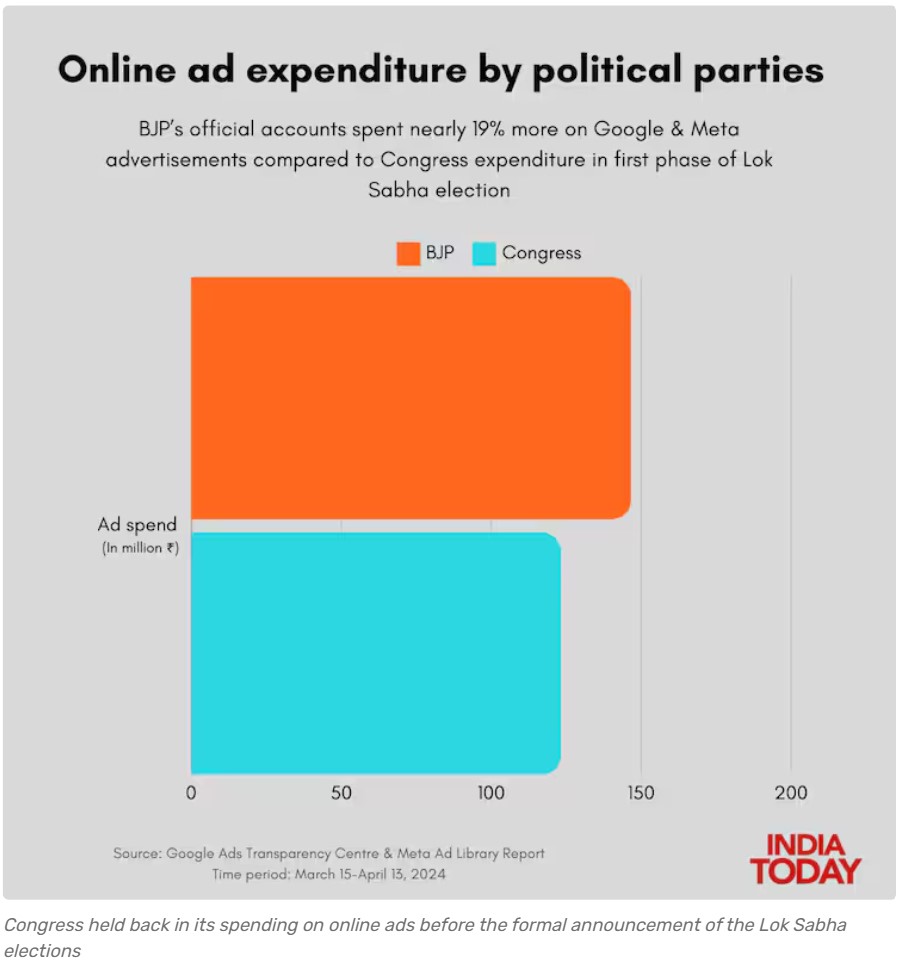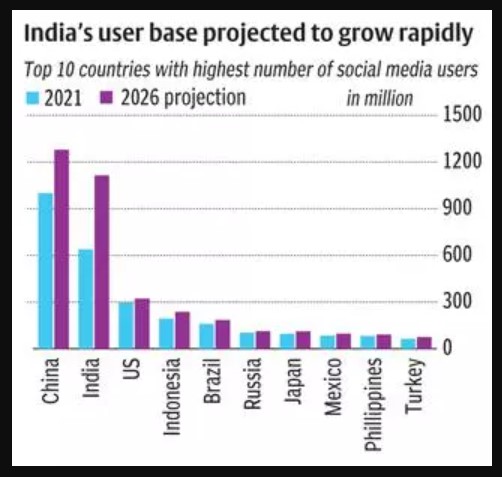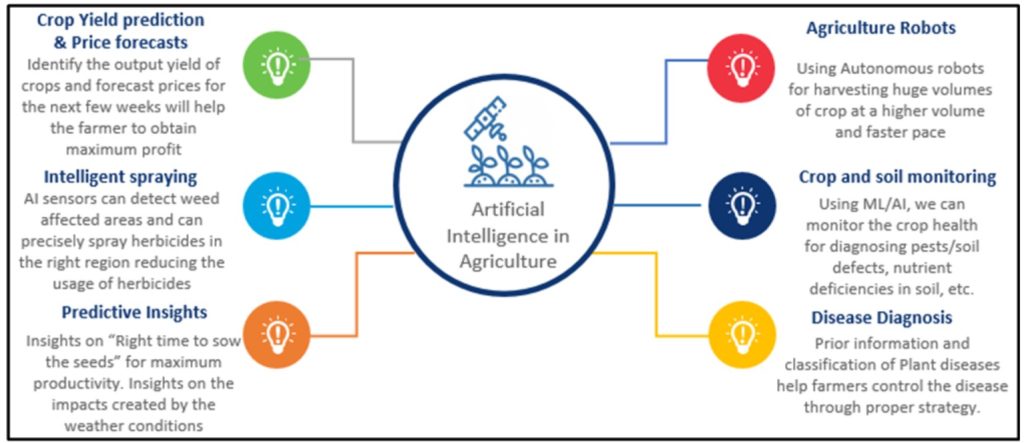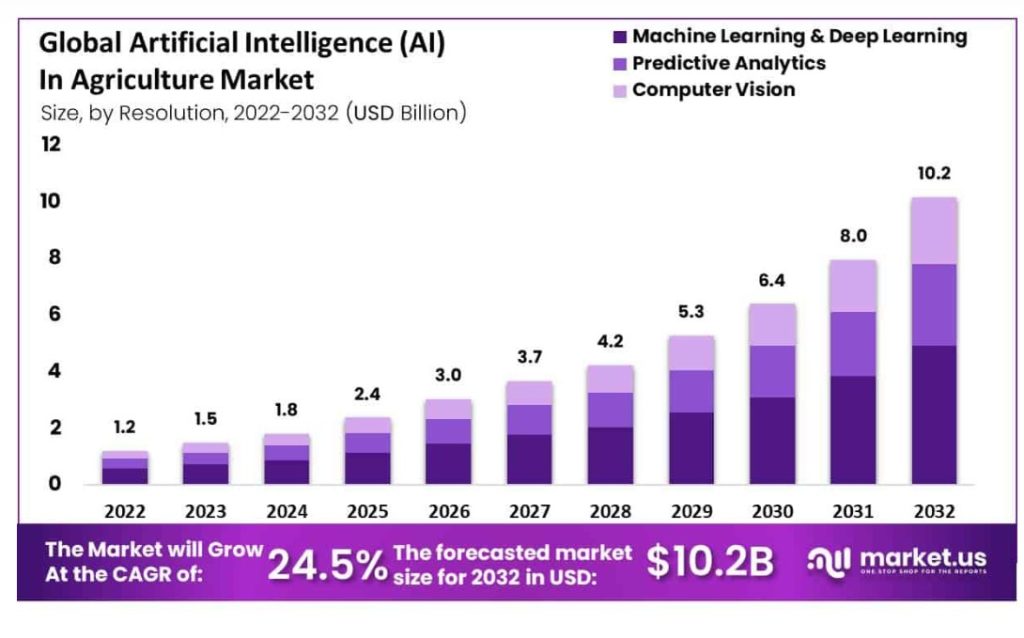CONTENTS
- Social Media’s Impact on Indian Politics
- AI is Revolutionising Sustainable, Tech-driven Farming
Social Media’s Impact on Indian Politics
Context:
This marks the first-ever social media-driven election in India, where social media platforms have provided avenues for diverse viewpoints beyond the reach of state influence, thereby creating cognitive dissonance with the government’s narrative. Notably, it is seen that a vast majority of the public are inclined to the shows and episodes of social media influencers revolving around elections.
Relevance:
- GS2- Government Policies and Interventions
- GS3- Role of Media and Social Networking Sites in Internal Security Challenges
Mains Question:
Do you agree with the view that is the first ever social media election in India? Discuss the significance that today’s social media holds in defining the political narrative of the masses? (15 Marks, 250 Words).
Rise of Social Media:
A Tool Utilised by the Ruling Government:
- In recent times, social media has predominantly served as a tool utilized by the ruling government. Initially, a “right-wing ecosystem” emerged on social media to counterbalance traditional media narratives, which were perceived as less politically aligned.
- Traditional media, during the early years, refrained from active fear-mongering, leaving this role to right-wing social media platforms, which openly expressed political biases and often crossed ethical boundaries in their commentary.
- As highlighted in Kunal Purohit’s insightful book “H-Pop: The Secretive World of Hindutva Pop Stars,” this digital space serves as a means to propagate hate and incite anger against minority groups and political opponents on a daily basis, without necessarily culminating in tangible events such as hate speech rallies or riots.

Ongoing Shift:
- However, there has been a shift, particularly as traditional media outlets began echoing much of the content propagated by the right-wing ecosystem, thus saturating the information landscape.
- People are becoming increasingly aware; even staunch supporters of the ruling party acknowledge the extent of this media control.
- With a more diverse population accessing information through mobile phones and seeking alternative viewpoints, an opportunity emerged for critical voices to be heard.
- Importantly, these voices do not align themselves with any particular political party, allowing them to gain the credibility that traditional media outlets may have lost.
- Consequently, many individuals we spoke to noted that they find it easier to discern the true state of affairs in India through social media channels.
Rise of the Influencer Club on Social Media:
- Ironically, the traditional media’s shift towards more sensationalized and biased content, possibly driven by a quest for survival, might have hastened its decline.
- Influencers who offer perspectives challenging the dominant narrative have swiftly capitalized on this shift, aided by social media algorithms.
- A key aspect of algorithms used by platforms like YouTube and Facebook is that content experiencing rapid growth in popularity is given greater visibility to the entire user base.
- Social media has provided a platform for political involvement among an increasingly hesitant electorate, often silenced by a climate of fear.
- The adoption of social media has been most rapid among the educated youth demographic, once considered a stronghold of support for the ruling government.

- However, after a decade, the aspirations that once defined this demographic have largely dissipated, replaced by frustration for many.
- Educated youth, disillusioned by a lack of employment opportunities and influenced by narratives on social media, have drifted away from the BJP—and this shift is reflected in electoral outcomes.
- At its core, this represents a positive development. In a democracy, the diversity of opinions and active engagement with political views are vital.
- The opening up of these spaces indicates the emergence of sites of democratic resurgence in India.
Laws Governing Media Conduct During Elections:
During elections, media regulation primarily falls outside the purview of the Election Commission. However, the Commission is tasked with enforcing laws and court directives that may intersect with media activities.
Several laws governing media conduct during elections include:
- Section 126 of the Representation of the People Act, 1951: This section prohibits the display of any election-related content via cinematograph, television, or similar devices during the 48-hour period leading up to the conclusion of the polls.
- Section 126A of the Representation of the People Act, 1951: This section prohibits the conduct of exit polls and the dissemination of their results during specified periods, including the time leading up to the commencement of polls in the first phase and a half-hour after the close of polls for the last phase across all states and union territories.
- Section 127A of the Representation of the People Act, 1951: This section governs the printing and publication of election-related materials such as pamphlets and posters, mandating that they bear the names and addresses of the printer and publisher.
- Section 171H of the Indian Penal Code: This section prohibits the incurring of expenditures on advertisements and other activities related to elections without the authorization of the contesting candidate.
Associated Concerns:
- Social media is diminishing the relevance of party workers and intermediaries. Political narratives are now being shaped outside the confines of the formal party system.
- Traditionally, party workers and intermediaries were responsible for presenting voters with political narratives, aligning them with the ideologies of their respective parties and eliciting policy demands from grassroots levels.
- This trend facilitates greater centralization within political parties, as leaders can directly craft narratives. Additionally, algorithms contribute to increased polarization. The impact of these changes on party structures and, more significantly, the public discourse, remains uncertain.
Conclusion:
Nevertheless, the ascendancy of social media as a primary player in this election is largely due to the retreat of traditional media from its professional duty of framing political issues with credibility. What implications does this hold for reasoned discourse and the overall health of Indian democracy? This question lies at the heart of the 2024 election.
AI is Revolutionising Sustainable, Tech-driven Farming
Context:
Despite the planet producing enough food to feed everyone, approximately one billion people remain hungry and malnourished due to various factors. With the world’s population projected to reach 9.7 billion by 2050, the agriculture sector faces mounting pressure to produce food more efficiently while minimizing resource use and environmental impact. Fortunately, AI holds significant promise for revolutionizing food systems and tackling these challenges head-on.
Relevance:
GS3-
- Cropping Patterns
- Food Security
- Artificial Intelligence
Mains Question:
By harnessing data-driven insights, AI empowers farmers to optimise resource allocation, mitigate environmental degradation and enhance crop yields. Discuss. (10 Marks, 150 Words).
Role of artificial intelligence (AI) in Agriculture:
The integration of artificial intelligence (AI) into agriculture is poised to address pressing issues such as food waste, climate change, and global hunger.

Data- Driven Insights:
- AI technology can empower farmers by providing data-driven insights to optimize resource utilization and reduce environmental footprint.
- By analyzing data from diverse sources, AI can help farmers make informed decisions about crop selection, planting times, and cultivation methods.
- According to analysis by the World Economic Forum, integrating AI into agriculture could lead to a 60% reduction in pesticide use and a 50% reduction in water usage.
Market Demand Analysis:
- Market demand analysis is a crucial aspect of modern agriculture, and AI can enhance this process by analyzing meteorological data, satellite imagery, and other relevant factors.
- AI algorithms can assist farmers in selecting the most profitable crops to grow, predicting market demand, and minimizing the risk of crop failures through forecasting and predictive analytics.
- Additionally, AI-powered software applications can assess the quality, freshness, and size of fruits and vegetables, enabling farmers to take proactive measures to maintain crop health and quality.
Enhancing Plant Breeding Efforts:
- AI technologies also play a vital role in enhancing plant breeding efforts and optimizing soil management practices.
- By gathering data on plant growth and performance, AI systems can identify high-performing plant varieties and facilitate the development of superior hybrids.
- Moreover, AI-based tools like the Nutrient Scanner can analyze soil samples to provide farmers with precise estimates of nutrient deficiencies, enabling them to optimize fertilization schedules and irrigation practices.
Pest and Disease Management:
- Furthermore, AI can contribute to pest and disease management by monitoring plant health, detecting diseases, and recommending appropriate treatments.
- By leveraging AI-driven insights, farmers can effectively manage weeds, pests, and diseases while minimizing the use of chemical inputs.
- AI technology can also recommend targeted treatments for pests, reducing reliance on broad-spectrum insecticides that can harm beneficial insects and contribute to pesticide resistance.
- AI-powered technologies enable rapid identification of plant diseases and pests, allowing farmers to take timely corrective actions. For example, an AI system can detect aphid infestations in a strawberry field, alert the farmer via smartphone, and recommend appropriate intervention measures.
- Additionally, AI can automate tasks such as insect or weed control, with robotic weeding achieving high accuracy rates through computer vision technology and significantly reducing pesticide usage.
Track Plant Maturity:
- Estimating crop growth and maturity can be challenging and time-consuming for farmers, but AI can perform this task accurately and efficiently.
- By utilizing AI-powered tools such as sensors and image recognition technology, farmers can monitor crop changes and accurately forecast ideal maturity times.
- Studies have shown that AI-based predictions of crop maturity outperform those made by human observers, potentially leading to significant cost savings and increased revenues for farmers.
Monitor Soil Conditions:
- Integrating sensors and AI systems allows farmers to precisely monitor soil conditions, including factors such as temperature, pH levels, nutrient content, and moisture levels.
- These sensors collect data that is then processed by AI algorithms to provide farmers with actionable insights for optimizing crop management practices.
The Path Ahead:
- The adoption of AI in agriculture is expected to grow substantially in the coming years, transforming the industry by improving efficiency, reducing waste, and increasing crop yields.
- Market research projects a rapid expansion of the AI in agriculture market, with a Compound Annual Growth Rate (CAGR) of 35.6%, leading to a market size increase from $2.35 billion in 2020 to $10.83 billion by 2025.

- This growth will enable more informed decision-making and contribute to addressing the global food security challenge by enhancing crop productivity.
Conclusion:
In summary, the application of AI in agriculture holds immense potential to transform food production systems, enhance sustainability, and address global food security challenges. By leveraging AI technologies, farmers can make more informed decisions, optimize resource utilization, and minimize environmental impact, ultimately contributing to a more resilient and sustainable agricultural sector.



